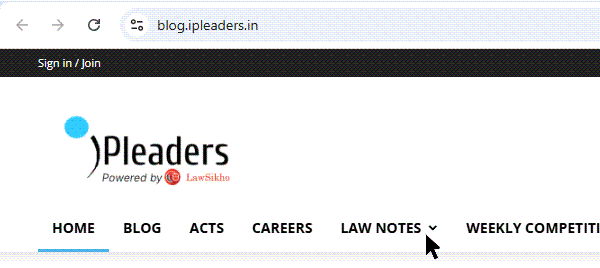This article is written by Swarnav Biswas pursuing US Technology Law and Paralegal Studies: Structuring, Contracts, Compliance, Disputes and Policy Advocacy from LawSikho.
This article has been published by Anshi Mudgal.
Table of Contents
Introduction
Chief Justice Marshall defines the company as “a company which is an artificial being, invisible, intangible, and exists only in contemplation of law.” In every ordinary law jurisdiction, a company is considered a separate legal entity that will differ from its members for ease of business. As a separate entity, a company can hold its property in its name, sue and be sued in its name, and enjoy the perpetual succession of its property, among others. It is given an artificial personality through its board of directors, though BOD can’t be sued.
Overview of winding-up processes
This process can be classified into different types, each with distinct legal and procedural requirements, including voluntary winding up. This occurs when a company dissolves itself through shareholders’ or creditors’ approval.
Definition of winding up
Winding up can be defined as ending the life of a corporation or a company by selling its property and assets only for the benefit of a company’s shareholders and creditors. Winding up (liquidation) is a process to pay off company debts when the company becomes insolvent by selling the company’s assets, and the remaining sums, after paying off its debts, expenses and costs, will be distributed amongst the company’s shareholders. As per the Cambridge Dictionary, “Winding up is the process of closing a business that is not successful and has debts that it cannot manage to pay the debts.” The winding up is also referred to as Liquidation in many countries.
General overview of types
In India, the winding up of the company is administered under the Company Act of 2013 and the Insolvency and Bankruptcy Code of 2016. The mechanism given under these two statutes allows different types of winding-ups. In India, two kinds of winding up are practised in corporate structure. One is voluntary winding up, and the other is a compulsory winding-up procedure. The compulsory winding is interchangeably referred to as the court-monitored winding-up procedure. Understanding the distinction between different types of winding up procedures for a company is essential. It’s necessary to understand the difference between the procedures, which are followed at varying times in various situations.
Voluntary winding up
Voluntary winding up used to happen when the company and its members found it no longer profitable, and they decided to cease its operation the company for eliminating future burden of losses. Though it’s not just a simple case of abandonment. It involves the fulfilment of complex legal procedures to voluntarily wind up or cease a company as this process ensures that the company has been dissolved legally and all the members and directors are not liable to pay any penalties.
Members’ voluntary winding up
A specific type of voluntary winding up is members’ voluntary winding up, which occurs when a company is a solvent, and its members choose to dissolve it through a structured legal process. Now, we will explore members’ voluntary winding up.
Criteria and eligibility
As prescribed in Section 59(1) of the Insolvency and Bankruptcy Code 2016, a corporate person is eligible for voluntary winding up. Further in this act, a corporate person has been defined as a company, a limited liability partnership or any other person incorporated with limited liability under any law. However, financial service providers like banks don’t come under the purview of a corporate person. This section also bars any person, per the definition given above, who has committed any default from voluntarily winding up.
Procedures involved
The procedures for the voluntary winding-up of a company are here as follows:
- The company shall have a declaration from the majority of the directors of the company stating that all of them have complete knowledge regarding the affairs of the company. Also, they all have confirmed that no debt is owed to any creditor. If there is, the company will be able to pay by liquidating assets in complete form, and it wants to proceed with voluntary liquidation.
- The company must also declare that they are not liquidated to any defrauded person.
The declaration will be given on INR 100 stamp paper in the case of Indian directors.
- In case of the directors signing the declaration in foreign countries, those declarations must be duly notarised and apostilled,
- There must be additional documents along with the declarations of the board of directors.
- Record of the company’s business operations along with the audited financial statements of the previous 2 years or for the period since its incorporation.
- If any registered valuer has made any report on the valuation of assets, that also needs to be submitted.
Within 4 weeks of submission of the director’s declaration, the company would call for a general meeting where they shall pass a special resolution requiring the company to be liquidated voluntarily and an insolvency professional to be appointed.
Creditors’ voluntary winding up
When is it applicable?
Creditors voluntary winding up is a process initiated by any company when it finds that it cannot and will not meet financial obligations to the creditors of the company. The procedure is governed under the Companies Act of 2013 and the Insolvency and Bankruptcy Code of 2016. It applies only when they cannot repay the debts owed to the creditors. The creditors voluntary winding up is only applicable for repaying the debts by selling the company’s assets.
Steps in the process
The steps in this process are as follows.
- The first step is to pass a special resolution with 75% board approval.
- Following the resolution, a liquidator will be appointed to manage the winding-up process and is responsible for selling off assets, paying debts, and distributing any remaining funds to stakeholders.
- The liquidator shall notify all the creditors about the winding-up process and will call for their claims.
- The liquidator then will verify all the claims of debts made by the creditors and will prioritise the claims as per the legal requirement.
- The liquidator will then sell the company’s assets to generate funds for settling debts.
- After repaying the debt, the remaining assets will be distributed among the shareholders according to their rights.
- After everything has settled, a final meeting would be held to present accounts of winding-up and following this, an application for dissolution is made to the companies register.
Impact on creditors and shareholders
This shows that creditor has a more significant impact and control over voluntary liquidation than the company’s shareholders. If it had been turned out that the solvency was false, directors may have faced severe legal action. The entire procedure aims to ensure that creditors are paid as much as possible while providing an orderly dissolution of the company’s operation.
Compulsory winding up
Court-ordered winding up
When any company incorporated under the Companies Act or registered or formed by the government has been dissolved by order of winding up by a high court or tribunal, the same is called a compulsory winding up of a company.
Grounds for compulsory winding up
As per the Companies Act of 2013, compulsory winding-up is only possible under certain circumstances. The following grounds are mentioned here as follows:
- When any company passes any special resolution it would be wound up only by the court or tribunal.
- If the company has acted against the national interest or indulged itself in any act that compromises the national sovereignty and integrity of India.
- The company has not filed financial statements or annual returns for five consecutive years.
- The tribunal or court has found that the company is involved in any fraudulent activity or that the company’s formation was for any unlawful purpose. The tribunal or court believes that winding up would be just and equitable.
Legal procedures
There as some steps for the compulsory winding-up of a company, which are described here as follows:
- The first step is to file a petition for winding up for the company, which could only be filed by specified persons, as mentioned earlier.
- The statement of affairs and complied audited books of company accounts must be submitted along with the petition.
- Advertisements under form 6 in a daily journal 14 days prior in the regional language of the perspective area and English must be submitted along with the petition and the company’s statement of affairs.
After reviewing all documents, if the court or tribunal is satisfied it will pass an order for the winding-up of a company. Upon receiving the judgement by the registrar of companies, the registrar will issue a notice to the official gazette mentioning the following company has been dissolved.
Winding up under the supervision of the court
Overview
Winding-up under the supervision of the court is a distinct process that occurs when the court or tribunal finds that the voluntary winding-up process has not been completed properly but requires judicial supervision. The process imposes judicial supervision in the voluntary winding-up process by retaining their authority to make orders and directions throughout the winding-up process to run it smoothly and transparently.
Process and legal requirements
The process is similar to the process of compulsory winding up.
Differences from compulsory winding up
Though the process and steps may be similar to compulsory winding-up, winding up under the supervision of a court is significantly different from the compulsory winding-up process initiated by a court. The differences are here as follows:
- In the compulsory winding-up process, any member or creditor comes with a winding-up petition before the court for winding up due to insolvency or in any other ground, but in case of winding up under the supervision of the court, starts with a voluntary resolution by the company itself.
- In compulsory winding up, the court retains full authority, but in case of voluntary winding up the court provides a judicial oversight on the process of winding up, but the initial decision to wind up still rests with the company’s members.
- Any company that goes for voluntary winding up with a petition to court may continue operation for effective liquidation but a case of compulsory winding up leads to immediate cessation of operations.
Roles of stakeholders in winding up
This section discusses the roles of stakeholders in winding up, highlighting the responsibilities of directors, shareholders, liquidators, and creditors in facilitating the winding-up process.
Directors
In the winding-up process, directors are responsible for acting for the best of the company and other fellow directors. Directors can be held accountable and liable if they have defaulted their duties in any manner of negligence.
Shareholders
Shareholders may pass a resolution for voluntary winding-up if they believe that the company need to be dissolved at the earliest. They all will be receiving any remaining funds after repaying debts after selling the company’s assets as per their rights. They also may be charged liable for any fraudulent act they committed.
Creditors
Creditors will file their claims outlining the amount owed to them by the company to the liquidator. After that, they will regularly attend the creditors’ meetings to vote on important decisions like the appointment of creditors and distribution of assets.
Liquidators
The liquidator is appointed by the tribunal or court or by shareholders to take care of the winding-up process, which includes selling assets, paying creditors their dues after selling the assets and distributing the remaining funds. The liquidator is authorised to investigate into company’s financial record if necessity arises. He will be responsible for updating the status of creditors and shareholders on the progress of the liquidation regularly.
Legal and financial implications
This part will explain the Legal and Financial Implications of winding up, examining the regulatory requirements, financial obligations, and potential consequences for stakeholders involved in the process.
Impact on company assets
Once a liquidator is assigned for liquidation of the company’s assets, the company loses all ownership from the assets of the company as these will be now utilised to sell and repay the debt owed to the creditors.
Employee rights and obligations
Employees are the primary priority creditors in the case of a company being wound up though they may face job losses and only will receive a small portion of their wages and benefits as the company is insolvent.
Creditors’ claims and priorities
Creditors are being paid with their debts owed to them according to hierarchy as secured creditors typically receive priority over unsecured creditors.
Alternatives to winding up
An alternative way to wind up is company restructuring. The process refers to the way where a company make significant changes in their super structure like operations, financial adjustments, organisational structure alteration, or asset realignment to improve their financial performance. The process is administered under the Companies Act of 2013 and the Insolvency and Bankruptcy Code of 2016. There are other remedies like mergers and acquisitions and debt restructuring based on the company’s situation rather than dissolving it completely via winding-up.
Conclusion
Winding up can be considered as the death of a company after it dissolves. The present three types of winding up have been prescribed under the Companies Act, of 2013 and IBC 2016 and have established NCLT to tackle the issue of winding up. And for the cases arising out of appeal, NCLAT will go. We can conclude that the winding up of a company is an essential instrument of debt repayment to creditors.
FAQs
- What is the difference between voluntary and compulsory winding up?
A Company’s voluntary winding up refers to the process when a company chooses to close its operation and deregister from the registrar of companies by initiating the process through a board resolution, while a company’s compulsory winding up is when a court orders to company to cease their operation upon receiving petitions from creditors when company is unable to pay creditors debt.
- Can a solvent company be wound up?
Yes, a solvent company can be wound up in India as per Indian statutory norms under the Companies Act 2013 and IBC 2016 by passing a resolution of voluntary winding up.
- What are the rights of employees during the winding-up process?
Employees have the right to receive compensation wages, salaries and other benefits prioritised over creditors as they would be paid first.
- How are creditors paid during winding up?
Creditors will file their claims outlining the amount owed to them by the company to the liquidator. After that, they will regularly attend the creditors’ meetings to vote on important decisions like the appointment of creditors and distribution of assets.
- Can a winding-up order be reversed?
Yes, a Winding-up order can be reserved through an appeal before NCLAT (National Company Law Appellate Tribunal).
- What happens to the company’s assets after winding up?
The company’s assets are being sold and utilised to pay the creditor’s debt.
References
- https://www.indiafilings.com/learn/modes-of-winding-up-of-a-company/
- https://www.accaglobal.com/in/en/student/exam-support-resources/fundamentals-exams-study-resources/f4/technical-articles/winding-up.html
- https://www.freshbooks.com/glossary/financial/winding-up?srsltid=AfmBOoqzupH8yzuJwkJYMGT_I2hMEhIkY6KwSY5s2RtRB00HT7CY4Knh
- https://legalwindow.in/modes-of-winding-up-of-a-company-as-per-companies-act/
 Serato DJ Crack 2025Serato DJ PRO Crack
Serato DJ Crack 2025Serato DJ PRO Crack










 Allow notifications
Allow notifications



